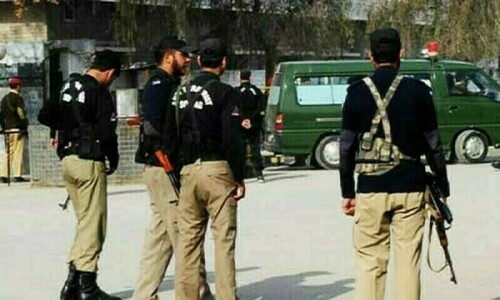SRINAGAR: Doctors are fighting to save the right eye of Hiba Jan, the 20-month-old who has become an emblem of India’s devastating and highly contentious use of pellet-firing shotguns in India-held Kashmir.
India began deploying the pump-action guns, which spew 600 metal shards at high velocity at a time, in 2010, since then killing dozens and maiming thousands in the disputed region.
As her husband sobbed, Hiba Jan’s mother Marsala said they were shot at while trying to escape from clouds of tear gas during disturbances last Sunday.
Troops were trying to push back thousands of villagers protesting after the deaths of six suspected fighters and a civilian in a fierce gunfight that also killed a soldier.
“As soon as I tried to open the metal wire mesh door to get out, a soldier outside fired pellets at us,” Marsala told AFP at the SMHS hospital in Srinagar.
“Instinctively, I covered Hiba’s eyes with my hand but pellets broke through the net and one lodged in her right eye,” she said as she sat in a dark waiting room crowded with other victims.
Violence in India-held Kashmir has killed tens of thousands since 1947. This year has been the bloodiest in nearly a decade with at least 530 dead so far.
India has about 500,000 soldiers in the part of Kashmir it occupies, where armed groups are fighting for independence or a merger with Pakistan.
India introduced the officially “non-lethal” 12-gauge pellet shotgun in the Himalayan region in 2010 when major anti-India protests and clashes with government forces left over 100 dead.
Government data from 2017 revealed the weapon killed 13 people and injured more than 6,000 in eight months alone, including nearly 800 with eye injuries.
The year 2016 is still recalled by locals as the year of mass blinding in held Kashmir, or as that of “dead eye epidemic”.
More than 1,200 victims — men, women and children — have organised themselves as an association since 2017, called the Pellet Victims Welfare Trust. Nearly 100 of them have both eyes severely damaged or are completely blinded.
Its chief Mohammad Ashraf, blind in one eye and with 635 pellets lodged in his body and head, said they came together after meeting and sharing stories in hospital. “We were like walking dead, emotionless and purposeless, a burden on our families,” he said.
Some of its members report having suicidal feelings.
Lawyers say most of the victims have been booked by police in cases like rioting, stone throwing, damaging public property, attempting to murder government forces personnel or even waging war against India.
Many with blinded eyes and other injuries are in jail under a preventive detention law that allows for imprisonment between three months and three years without charge.
“Not a single case has reached the stage of trial,” said human rights lawyer Arshid Andrabi.
‘Lethal at close range’
India’s interior minister said in 2016 that the pellet guns were used as a last resort but refused to stop deploying it for crowd control.
The Central Reserve Police Force (CRPF), the Indian paramilitary force deployed in the Himalayan region, told a court in 2016 that they fired about 1.3 million pellets in just 32 days.
In June this year, a report rejected by India from the UN human rights office called for a major investigation into abuses in held Kashmir, highlighting the use of pellet guns as an area of concern.
Amnesty International has urged the Indian government to ban the use of pellet guns, and lawyers and other rights groups have appealed to courts, to little avail so far.
The US-based Physicians for Human Rights has called their use “inherently inaccurate [and] indiscriminate”, and potentially “lethal to humans at close range”.
Published in Dawn, December 1st, 2018













































Dear visitor, the comments section is undergoing an overhaul and will return soon.